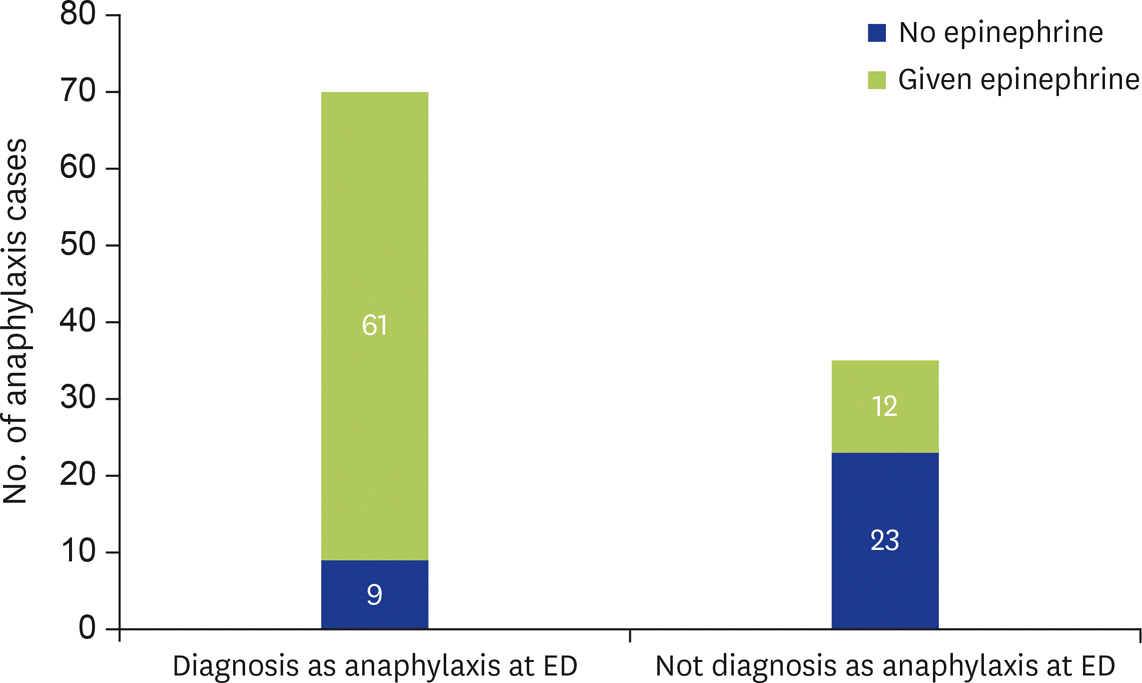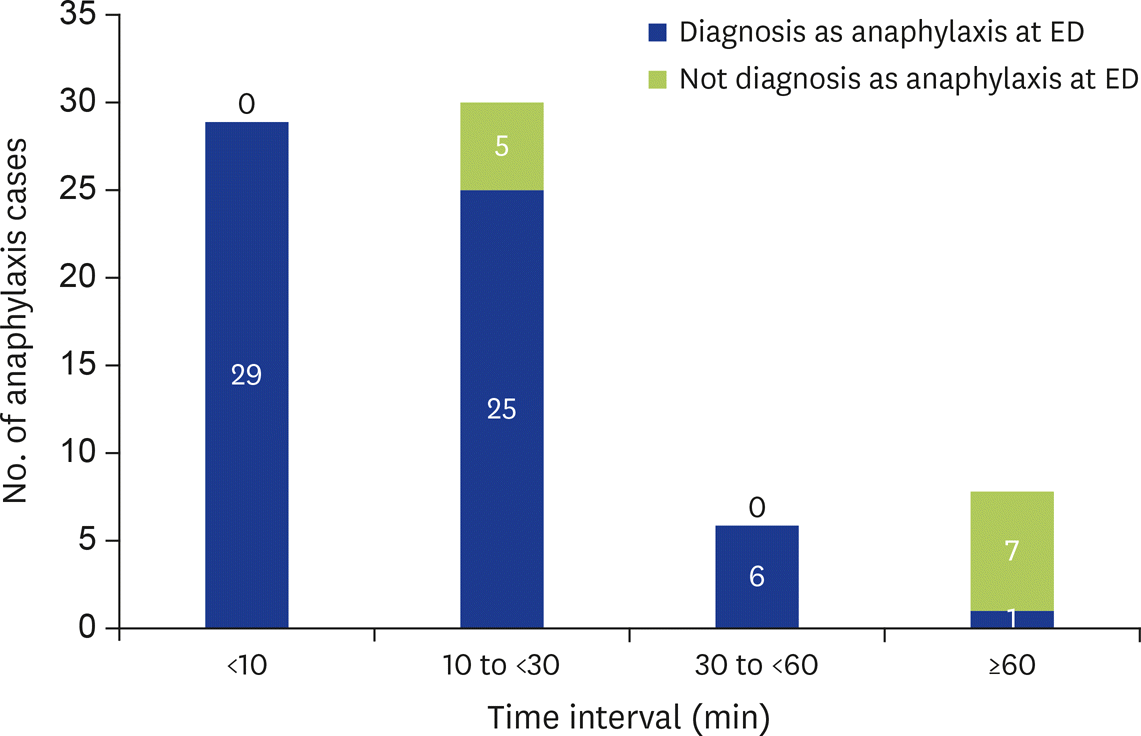Abstract
Background
In the Emergency Department (ED), diagnosis and management of anaphylaxis are challenging with at least 50% of anaphylaxis episodes misdiagnosed when the diagnostic criteria of current guidelines are not used.
Objective
Objective of our study was to assess anaphylaxis diagnosis and management in patients presenting to the ED.
Methods
Retrospective chart review conducted on patients presenting to The Medical City Hospital ED, the Philippines from 2013–2015 was done. Cases were identified based on International Statistical Classification of Diseases, 10th revision coding for either anaphylaxis or other allergic related diagnosis. Cases fitting the definition of anaphylaxis as identified by the National Institute of Allergy and Infectious Disease and the Food Allergy and Anaphylaxis Network (NIAID/FAAN) were included. Data collected included demographics, signs and symptoms, triggers and management.
Results
A total of 105 cases were evaluated. Incidence of anaphylaxis for the 3-year study period was 0.03%. Of the 105 cases, 35 (33%) were diagnosed as “urticaria” or “hypersensitivity reaction” despite fulfilling the NIAID/FAAN anaphylaxis criteria. There was a significant difference in epinephrine administration between those given the diagnosis of anaphylaxis versus misdiagnosed cases (61 [87%] vs. 12 [34%], χ2 = 30.77, p < 0.01); and a significant difference in time interval from arrival at the ED to epinephrine administration, with those diagnosed as anaphylaxis (48%) receiving epinephrine within 10 minutes, versus ≥ 60 minutes for most of the misdiagnosed group (χ2 = 52.97, p < 0.01).
Go to : 
References
1. Sampson HA, Muñoz-Furlong A, Campbell RL, Adkinson NF Jr, Bock SA, Branum A, Brown SG, Camargo CA Jr, Cydulka R, Galli SJ, Gidudu J, Gruchalla RS, Harlor AD Jr, Hepner DL, Lewis LM, Lieberman PL, Metcalfe DD, O'Connor R, Muraro A, Rudman A, Schmitt C, Scherrer D, Simons FE, Thomas S, Wood JP, Decker WW. Second symposium on the definition and management of anaphylaxis: summary report–second National Institute of Allergy and Infectious Disease/Food Allergy and Anaphylaxis Network symposium. Ann Emerg Med. 2006; 47:373–80.

2. Neugut AI, Ghatak AT, Miller RL. Anaphylaxis in the United States: an investigation into its epidemiology. Arch Intern Med. 2001; 161:15–21.
3. Simons FE, Ebisawa M, Sanchez-Borges M, Thong BY, Worm M, Tanno LK, Lockey RF, El-Gamal YM, Brown SG, Park HS, Sheikh A. 2015 update of the evidence base: World Allergy Organization anaphylaxis guidelines. World Allergy Organ J. 2015; 8:32.

4. Campbell RL, Hagan JB, Manivannan V, Decker WW, Kanthala AR, Bellolio MF, Smith VD, Li JT. Evaluation of national institute of allergy and infectious diseases/food allergy and anaphylaxis network criteria for the diagnosis of anaphylaxis in emergency department patients. J Allergy Clin Immunol. 2012; 129:748–52.

5. Sicherer SH, Simons FE. Section on Allergy and Immunology, American Academy of Pediatrics. Self-injectable epinephrine for first-aid management of anaphylaxis. Pediatrics. 2007; 119:638–46.

6. Alvarez-Perea A, Tomás-Pérez M, Martínez-Lezcano P, Marco G, Pérez D, Zubeldia JM, Baeza ML. Anaphylaxis in adolescent/adult patients treated in the Emergency Department: differences between initial impressions and the definitive diagnosis. J Investig Allergol Clin Immunol. 2015; 25:288–94.
7. Russell WS, Farrar JR, Nowak R, Hays DP, Schmitz N, Wood J, Miller J. Evaluating the management of anaphylaxis in US emergency departments: Guidelines vs. practice. World J Emerg Med. 2013; 4:98–106.

8. Khan NU, Shakeel N, Makda A, Mallick AS, Ali Memon M, Hashmi SH, Khan UR, Razzak JA. Anaphylaxis: incidence, presentation, causes and outcome in patients in a tertiary-care hospital in Karachi, Pakistan. QJM. 2013; 106:1095–101.

9. Techapornroong M, Akrawinthawong K, Cheungpasitporn W, Ruxrungtham K. Anaphylaxis: a ten years inpatient retrospective study. Asian Pac J Allergy Immunol. 2010; 28:262–9.
10. Simons FE, Ardusso LR, Bilò MB, El-Gamal YM, Ledford DK, Ring J, Sanchez-Borges M, Senna GE, Sheikh A, Thong BY. World Allergy Organization. World Allergy Organization anaphylaxis guidelines: summary. J Allergy Clin Immunol. 2011; 127:587–93.

11. Klein JS, Yocum MW. Underreporting of anaphylaxis in a community emergency room. J Allergy Clin Immunol. 1995; 95:637–8.

12. Tanno LK, Ganem F, Demoly P, Toscano CM, Bierrenbach AL. Undernotification of anaphylaxis deaths in Brazil due to difficult coding under the ICD-10. Allergy. 2012; 67:783–9.

13. Trojan T, Ma Y, Khan DA. Anaphylaxis identification using direct and combined ICD-9 methods. J Allergy Clin Immunol. 2013; 131(2 Suppl):AB224. https://www.jacionline.org/article/S0091-6749(12)03466-5/abstract.

15. Kastner M, Harada L, Waserman S. Gaps in anaphylaxis management at the level of physicians, patients, and the community: a systematic review of the literature. Allergy. 2010; 65:435–44.

16. Campbell RL, Li JT, Nicklas RA, Sadosty AT. Members of the Joint Task Force. Practice Parameter Workgroup. Emergency department diagnosis and treatment of anaphylaxis: a practice parameter. Ann Allergy Asthma Immunol. 2014; 113:599–608.

17. Bansal PJ, Marsh R, Patel B, Tobin MC. Recognition, evaluation, and treatment of anaphylaxis in the child care setting. Ann Allergy Asthma Immunol. 2005; 94:55–9.

18. Clark S, Bock SA, Gaeta TJ, Brenner BE, Cydulka RK, Camargo CA. Multicenter Airway Research Collaboration-8 Investigators. Multicenter study of emergency department visits for food allergies. J Allergy Clin Immunol. 2004; 113:347–52.

19. Gaeta TJ, Clark S, Pelletier AJ, Camargo CA. National study of US emergency department visits for acute allergic reactions, 1993 to 2004. Ann Allergy Asthma Immunol. 2007; 98:360–5.

20. Gompels LL, Bethune C, Johnston SL, Gompels MM. Proposed use of adrenaline (epinephrine) in anaphylaxis and related conditions: a study of senior house officers starting accident and emergency posts. Postgrad Med J. 2002; 78:416–8.

21. Haymore BR, Carr WW, Frank WT. Anaphylaxis and epinephrine prescribing patterns in a military hospital: underutilization of the intramuscular route. Allergy Asthma Proc. 2005; 26:361–5.
22. Krugman SD, Chiaramonte DR, Matsui EC. Diagnosis and management of food-induced anaphylaxis: a national survey of pediatricians. Pediatrics. 2006; 118:e554–60.

23. Bernstein DI, Wanner M, Borish L, Liss GM. Immunotherapy Committee, American Academy of Allergy, Asthma and Immunology. Twelve-year survey of fatal reactions to allergen injections and skin testing: 1990-2001. J Allergy Clin Immunol. 2004; 113:1129–36.

24. Bock SA, Muñoz-Furlong A, Sampson HA. Fatalities due to anaphylactic reactions to foods. J Allergy Clin Immunol. 2001; 107:191–3.

25. de Silva IL, Mehr SS, Tey D, Tang ML. Paediatric anaphylaxis: a 5 year retrospective review. Allergy. 2008; 63:1071–6.
27. Pumphrey RS. Lessons for management of anaphylaxis from a study of fatal reactions. Clin Exp Allergy. 2000; 30:1144–50.

28. Wood RA, Camargo CA Jr, Lieberman P, Sampson HA, Schwartz LB, Zitt M, Collins C, Tringale M, Wilkinson M, Boyle J, Simons FE. Anaphylaxis in America: the prevalence and characteristics of anaphylaxis in the United States. J Allergy Clin Immunol. 2014; 133:461–7.

29. Jose R, Clesham GJ. Survey of the use of epinephrine (adrenaline) for anaphylaxis by junior hospital doctors. Postgrad Med J. 2007; 83:610–1.

30. Mehl A, Wahn U, Niggemann B. Anaphylactic reactions in children–a questionnaire-based survey in Germany. Allergy. 2005; 60:1440–5.
31. Thain S, Rubython J. Treatment of anaphylaxis in adults: results of a survey of doctors at Dunedin Hospital, New Zealand. N Z Med J. 2007; 120:U2492.
32. Sheikh A, Shehata YA, Brown SG, Simons FE. Adrenaline for the treatment of anaphylaxis: cochrane systematic review. Allergy. 2009; 64:204–12.

34. Ma L, Danoff TM, Borish L. Case fatality and population mortality associated with anaphylaxis in the United States. J Allergy Clin Immunol. 2014; 133:1075–83.

35. McBride D, Keil T, Grabenhenrich L, Dubakiene R, Drasutiene G, Fiocchi A, Dahdah L, Sprikkelman AB, Schoemaker AA, Roberts G, Grimshaw K, Kowalski ML, Stanczyk-Przyluska A, Sigurdardottir S, Clausen M, Papadopoulos NG, Mitsias D, Rosenfeld L, Reche M, Pascual C, Reich A, Hourihane J, Wahn U, Mills EN, Mackie A, Beyer K. The EuroPrevall birth cohort study on food allergy: baseline characteristics of 12,000 newborns and their families from nine European countries. Pediatr Allergy Immunol. 2012; 23:230–9.

36. Roehr CC, Edenharter G, Reimann S, Ehlers I, Worm M, Zuberbier T, Niggemann B. Food allergy and non-allergic food hypersensitivity in children and adolescents. Clin Exp Allergy. 2004; 34:1534–41.

37. Woods RK, Stoney RM, Raven J, Walters EH, Abramson M, Thien FC. Reported adverse food reactions overestimate true food allergy in the community. Eur J Clin Nutr. 2002; 56:31–6.

38. Nurmatov U, Worth A, Sheikh A. Anaphylaxis management plans for the acute and long-term management of anaphylaxis: a systematic review. J Allergy Clin Immunol. 2008; 122:353–61.

39. Kemp SF, Lockey RF, Simons FE. World Allergy Organization ad hoc Committee on Epinephrine in Anaphylaxis. Epinephrine: the drug of choice for anaphylaxis. A statement of the World Allergy Organization. Allergy. 2008; 63:1061–70.

40. NIAID-Sponsored Expert Panel. Boyce JA, Assa'ad A, Burks AW, Jones SM, Sampson HA, Wood RA, Plaut M, Cooper SF, Fenton MJ, Arshad SH, Bahna SL, Beck LA, Byrd-Bredbenner C, Camargo CA Jr, Eichenfield L, Furuta GT, Hanifin JM, Jones C, Kraft M, Levy BD, Lieberman P, Luccioli S, McCall KM, Schneider LC, Simon RA, Simons FE, Teach SJ, Yawn BP, Schwaninger JM. Guidelines for the diagnosis and management of food allergy in the United States: report of the NIAID-sponsored expert panel. J Allergy Clin Immunol. 2010; 126(6 Supp):S1–58.
41. Lieberman P, Nicklas RA, Randolph C, Oppenheimer J, Bernstein D, Bernstein J, Ellis A, Golden DB, Greenberger P, Kemp S, Khan D, Ledford D, Lieberman J, Metcalfe D, Nowak-Wegrzyn A, Sicherer S, Wallace D, Blessing-Moore J, Lang D, Portnoy JM, Schuller D, Spector S, Tilles SA. Anaphylaxis–a practice parameter update 2015. Ann Allergy Asthma Immunol. 2015; 115:341–84.

42. Simons FE, Ardusso LR, Bilò MB, Cardona V, Ebisawa M, El-Gamal YM, Lieberman P, Lockey RF, Muraro A, Roberts G, Sanchez-Borges M, Sheikh A, Shek LP, Wallace DV, Worm M. International consensus on (ICON) anaphylaxis. World Allergy Organ J. 2014; 7:9.

43. Kaplan MS, Jung SY, Chiang ML. Epinephrine autoinjector refill history in an HMO. Curr Allergy Asthma Rep. 2011; 11:65–70.

44. Song TT, Worm M, Lieberman P. Anaphylaxis treatment: current barriers to adrenaline autoinjector use. Allergy. 2014; 69:983–91.

Go to : 
 | Fig. 1.Epinephrine administration in anaphylaxis cases. ED, Emergency Department. χ2 = 30.767, p < 0.01. |
 | Fig. 2.Time interval from arrival at Emergency Department (ED) to administration of epinephrine. χ2 = 2.969, p < 0.05. |
Table 1.
Patient characteristics (n = 105)
Table 2.
Diagnosis of anaphylaxis in relation to history of anaphylaxis
Table 3.
Identified triggers of anaphylaxis
Table 4.
Chief complaint and signs and symptoms of anaphylaxis cases
Table 5.
Diagnosis of anaphylaxis in relation to presence of symptoms
Table 6.
Management care plan




 PDF
PDF ePub
ePub Citation
Citation Print
Print


 XML Download
XML Download